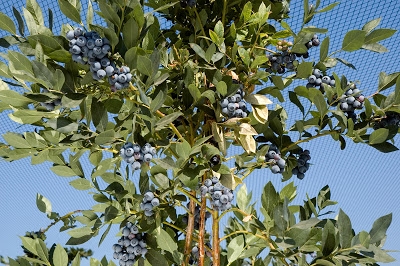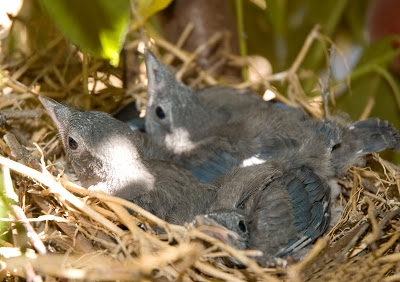LBAM in NYT
http://www.nytimes.com/2007/06/18/us/18moth.html?ex=1339905600&en=f29683b58074a45f&ei=5124&partner=permalink&exprod=permalink
http://www.nytimes.com/2007/06/18/us/18moth.html?ex=1339905600&en=f29683b58074a45f&ei=5124&partner=permalink&exprod=permalink
There’s an article in today’s Bee about light brown apple moth (LBAM) monitoring at Green Acres Nursery in Roseville. Apparently, they receive plants from a Bay Area wholesaler deep in the quarantine area. I’ll bet a lot of our local nurseries do.
The article emphasizes that the main concern is not about the potential damage to California plants, but about economic losses in quarantined regions. The San Francisco Bay Area is currently under a Federal Domestic Quarantine Order. Sacramento and the Sierra Nevada Foothills could be next.
If the moth starts showing up in local nurseries, they will face quarantines, which will force them to spray… at first with Neem oil, then with nastier chlorpyrifos if the invasion becomes an infestation. And until they pass agricultural inspection, nurseries presumably won’t be able to ship plants.
As a gardener, it begs the question “What if I do a little shopping in the Bay Area and bring my LBAM-laden plants home to Sacramento? Wouldn’t that do a disservice to local nurseries trying to prevent LBAM from invading?” Hmmm…
Should we become familiar with all stages of the moth and get ready with the Neem oil if we see it on our plants? Should we ask Bay Area nurseries if they’re monitoring for LBAM? Or should we leave the problem to natural enemies of the LBAM, which include the following:
The California Department of Food & Agriculture has put out a nice brochure on the LBAM showing pupal, caterpillar and adult stages and urges you to call 1-800-491-1899 if you discover signs of damage or the insect itself.
You’ve probably seen Dave Wilson Nursery fruit and nut trees at local nurseries inside California, outside California, and in mail order catalogs. If you’ve heard about growing “fruit shrubs” or practicing “backyard orchard culture”, these are the folks promoting it and educating us about this revolutionary, gardener-friendly method of growing fruit.
A few years ago, I had the privilege of attending a talk by Ed Laivo, DWN’s Retail Nursery Specialist and Field Rep., and it sold me on the technique. He’s right… we gardeners are not farmers! We do not have mechanized harvesting machines designed for picking fruit waaaaay up in the air. It totally makes sense to keep what you grow closer to the ground. Selecting trees on dwarfing rootstocks helps, as does summer pruning.
I was psyched about backyard orchard culture, but it wasn’t until I saw mature examples of “fruit shrubs” at the Fair Oaks Horticulture Center that I knew I had to grow my own. So far, I have three plums planted 18 inches apart and a cherry nearby. I have citrus as well, but that’s a Four Winds story.
My plum trees were selected from a catalog without the benefit of any pre-selection tasting. The cherry, a ‘Stella’, I already knew I loved. If you have a chance to attend any public tastings before buying trees, you’ll be sure your investment in trees and time will yield nothing but deliciousness.
If you missed this years tasting like I did (grumble, grumble), you can still benefit from the published tasting results gathered by DWN since 1993. Fruit tasting data is extremely useful because it gives growers and their customers a chance to compare old varieties with new varieties and to narrow the list of what’s bought and sold down to only the best-tasting fruit. If only grocery stores did the same…
According to DWN’s Mike Tomlinson,”preliminary results (of this year’s tasting) show at least a four way tie between Tomcot apricot and three blueberries; Misty, Reveille and Southmoon.” Last year’s results can be downloaded here.
‘Reveille’ Blueberry, one of the taller varieties
Mike added that, “Dave Wilson Nursery has been doing fruit tastings for 14 years now, the first few years only here in Hickman. Since about 1995, all the tastings have been on the road, at various locations in California, such as Cal Poly Pomona and San Luis Obispo. A couple of tastings have been at Copia in Napa… This open house was a homecoming of sorts.”
On how tests were conducted, Mike explained, “We invited our customers, garden writers and CRFG members. We started at 10 am with the first of 35ish varieties. Testers sampled each variety and rated them on various attributes, such as ripeness, texture and flavor, in the blind. After they are finished, we give them another and then tell them what the previous fruit was. This is to prevent a former impression they may have of the variety from influencing their evaluation process.”
Paul Guy, a statistics teacher from Chico (on left)
and Sacramento’s own Farmer Fred Hoffman (on right)
After the tasting, participants were treated to lunch. No fruit. After lunch, they toured the nursery and saw high-density demonstration plantings.
Ed Laivo discussing high-density plantings
Also wanting lunch were these DWN peach tree residents Mike Tomlinson happened upon while picking fruit.
15 days later
Is there a DWN tasting near you?
Check the DWN Events Calender!
For additional coverage of the event, see Modesto Bee Reporter John Holland’s piece on this year’s tasting.
(photos courtesy of Mike Tomlinson, Dave Wilson Nursery)
In my estimation, independent retail nurseries are on the decline in greater Sacramento, especially those located within city limits. Eisley Nursery in the city of Auburn has been in the news lately and the key words of concern are “blighted” and “eminent domain”. The 100-year-old well-maintained nursery appears safe for now, but let’s stay on top of this story.
Here’s a post I made after my first visit to Eisley’s.
This caught my eye in the Wayside Gardens catalog. Dark blue agapanthus is nothing new, but the blackish stems of ‘Back in Black’ might be, I believe. It’d be fun to pair this with something chartreuse… and it’d be crazy fun to put it with something red or orange.


Just got back from my cousin’s UCLA graduation. Temps were in the very comfortable seventies. Despite the coastal mildness of L.A. proper, I’m always struck by the incongruity of scrubby desert in surrounding areas and the opulent tropical lushness in landscaped parts of Los Angeles… especially in Beverly Hills.
Our celebration dinner was at Cha Cha Cha in Silverlake. A scene in Steve Martin’s Shop Girl was filmed at this Carribbean restaurant and Mr. Martin was reportedly a regular. Probably until he put it in his movie. The food was great, as was the fruit-filled Sangria. If you go, try the Crispy Shrimp Cakes, the Guacamole and Dirty Chips, and the Empanadas. Mmmm… Extra points for fun container plantings outside the restaurant.





The Jacaranda trees are in full bloom on the UCLA campus, which was a real treat for me since lavender is one of my favorite colors and I’ve never seen any Jacaranda trees growing in Sacramento.
June 20 edit: My friend, Weeder, informs me that she saw a Jacaranda blooming “in Sac. this Sunday.” Where?!!! I also vaguely remember seeing them for sale at POW once. The plot thickens. Sunset says it needs full sun, moderate water, prefers sandy soil but will tolerate other types (like my clay?), and is damaged below 25 degrees F. Why don’t we see it more often in northern California? It doesn’t seem like an impossibility. I hope someone will enlighten me.

